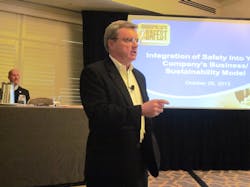ASC 2013: Safety 'Missed the Boat' on the Corporate Sustainability Movement
It's become standard practice for Fortune 500 companies to set big sustainability goals, measure their environmental performance and trumpet the results in their annual reports. But three decades after sustainability emerged as a mainstream issue for corporate America, workplace safety and health still resides in the shadows, by comparison.
"We missed the boat," NIOSH Director John Howard said during a panel discussion at the 2013 America's Safest Companies Conference in Atlanta. "We're 30 years behind the sustainability movement. We have to catch up, and we have to catch up fast."
For safety to receive equal billing with sustainability, the profession needs to change the way that it measures and communicates its value, the panelists asserted.
“You go into an operations meeting, and you have finance, quality and production all standing there talking. As soon as EHS walks in the room, it goes quiet,” said Michael Vigezzi, General Electric Co.’s global manager for VPP and safety programs. “Why? Do we have the acumen to come to the table [with other departments], or are we just the fire extinguisher people?”
Part of the problem is that EHS professionals – whether out of habit or necessity – traditionally have focused their energy on compliance with policies, procedures and regulatory standards, Vigezzi said.
“When we hire safety people, it’s very hard to find someone who can go into a facility with 2,000 people, understand the gaps to get us to excellence there and show me a three- to five-year plan on how we’re going to close those gaps,” said Dusty Ferrell, vice president of global safety and health for Georgia Pacific. “Because they’re always in firefighting mode.”
For EHS professionals to earn a more prominent spot at the table, “we need to realize that we have to focus on partnerships, not just compliance,” Vigezzi added.
“At GE, we’ve been looking more for generalists rather than specialists,” Vigezzi explained.
“We need them to understand engineering. We need them to understand operations. They have to be able to work in partnership so we’re no longer a tollgate.”
Focus on Leading Indicators
As the EHS profession tries to make safety a more intrinsic part of sustainability efforts and overall business operations, the panelists agreed that there needs to be a much greater emphasis on leading indicators.
"We're 30 years behind, but we have a lot of information and we're doing a lot of great things," GE's Vigezzi said.
"We just need to come to the table and be able to talk about it, and that's our biggest gap – we don't know how to communicate what we do in safety other than talking about injury and illness rates and lost-time rates."
GE, Georgia Pacific and a growing number of firms are measuring their safety success with leading indicators such as training hours, audit participation, near misses and preventive maintenance, in addition to traditional injury and illness data.
"There are a lot of indicators that tell you the healthiness of your EHS process" [other than lost-time injury rates], Vigezzi said. "Pull them into the forefront. It'll take some time. We're still struggling through it, but we're getting better at it."
Sustainability of the Workforce
The panelists also suggested that the safety profession can level the playing field with the environmental movement by redefining itself as a steward of workforce sustainability.
Georgia Pacific, for example, defines safety excellence as creating and maintaining a high quality of life for its associates – before and after they retire.
"If someone spent his life working for us, what I mean by quality of life is, can I bend over and pick up my granddaughter tonight?" Ferrell said. "Or do I have to say, 'No baby, I can't pick you up, I have to wear a back brace because I worked for this company.'"
Howard noted that NIOSH is working with the U.S. Green Building Council to incorporate occupational safety and health indicators into its popular LEED certification program.
"That way a company can be viewed not only by the nice skylights that it has in its building but also by how that company treated" workers during the construction of the building, Howard said. "There's a whole scope of sustainability that we have in front of us."
